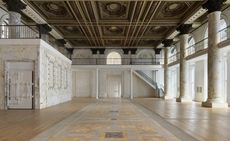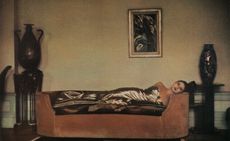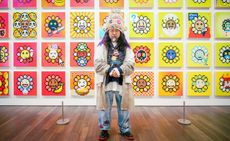The Whitney plots Harold Cohen’s artistic AI adventures
‘Harold Cohen: AARON’, at the Whitney Museum of American Art celebrates the artist’s software – the earliest AI program for artmaking – as an artwork in its own right

To dismiss the role of the artist in the increasingly frenzied conversations around artificial intelligence (AI) is to bypass swathes of art history which put man on equal footing with machine.
For artist Harold Cohen, who developed the first AI artmaking programme in the late 1960s, AARON, the resulting creativity stemmed from an equal collaboration between the programme and the programmer. Drawing directly from rules coded personally by the artist – unlike today’s software, which gathers information from existing imagery, guided by prompts from the user – Cohen’s AARON machine software is an artwork in its own right.

Harold Cohen, AARON KCAT, 2001. Screenshot. Artificial intelligence software. Dimensions variable
This early creativity and potential that Cohen spotlighted in AI is now being explored by an exhibition at the Whitney Museum of American Art, New York, inviting visitors to witness AARON in action. ‘Revisiting Harold Cohen’s AARON is crucial at this moment in time since it can teach us so much about AI art practice,’ says Christiane Paul, curator of digital art at the Whitney. She cites the rapid development of AI since 2021 – with tools including Dall-E, Midjourney, and Stable Diffusion bringing AI’s role in creating images into the mainstream – as why now is the right time to revisit Cohen’s contribution.
‘Harold Cohen: AARON’ at the Whitney, New York

Harold Cohen, AARON KCAT, 2001. Screenshot. Artificial intelligence software. Dimensions variable.
‘First of all, AARON illustrates the long history of AI art, underscoring that artists have been engaging with artificial intelligence for decades. Leaving behind a career as a successful abstract painter, Harold Cohen started developing his artmaking software in the late 1960s, named it AARON in 1973, and developed it until his death in 2016,’ says Paul.
‘Moreover, AARON shows us a very different approach to artmaking with AI than the current tools. AARON represents early, so-called “symbolic” AI; it is an expert system operating on the basis of rules and hasn’t been trained on previously existing images. It therefore doesn’t entail any of the standardisation, averaging, and optimisation used in the current models that have been trained on massive data sets of existing images.
‘AARON is coded as an artmaking program that has external knowledge of the world and the objects in it and internal knowledge of how to visually represent the objects. In addition, AARON nicely demonstrates the output of AI across different materialities. The creations of the AARON software are shown in the exhibition as projections, as paintings, and as plotter drawings created live in the gallery. Harold Cohen understood his work with the AARON software as a collaboration, and his practice raises a lot of important issues about authorship and agency that are crucial to today’s discussions.’

Harold Cohen, AARON KCAT, 2001. Screenshot. Artificial intelligence software. Dimensions variable
For Paul, it was also vital to underscore the status of the AARON software as the artwork, separate to its output of paintings, plotted drawings and digital images. ‘It was important to me to make this distinction and emphasise that Cohen’s software itself and its processes of visually representing the world are the artwork and creative engine behind the generative output,’ she adds.
Modern recreations of the drawing machines Cohen created early in his career will be on view at the exhibition, as well as live demonstrations by AARON of the drawing process with pen plotters. ‘I believe there is enormous potential for creativity in AI tools, but it still takes artists’ deep engagement with them to generate truly creative work,’ says Paul. ‘It is important to keep in mind that Cohen didn’t use an “off-the-shelf”, corporate AI software, he literally wrote his tool from scratch and evolved it through different phases, from abstract, evocative shapes to figures and jungle-like environments.
‘There are many things we can take away from Cohen’s work. Most importantly, he invites us to ask what art is, what defines art. Cohen always made work about the meaning of art, inquiring at what point a mark creates meaning and how an artist perceives and represents the world. At the core of AARON is Cohen’s Freehand Line Algorithm that makes all the output look like it has been drawn by hand.
‘For Cohen, something could be art only if it had intention, and AARON is all about the intentionality of the line. AARON invites us to rethink what constitutes art, the intention of art, as well as authorship and agency in the collaboration with machines. One could also see AARON as a proposal for a combination of more old-fashioned expert systems with today’s statistical text-to-image models.’
'Harold Cohen: AARON' takes place 3 Feb – May 2024 at Whitney Museum of American Art
From 8 March - 11 May, Cohen's work will be exhibited at London's Gazelli Art House, London gazelliarthouse.com

Harold Cohen, screenshots from AARON KCAT, 2001. Artificial intelligence software, dimensions variable
Wallpaper* Newsletter
Receive our daily digest of inspiration, escapism and design stories from around the world direct to your inbox
Hannah Silver is the Art, Culture, Watches & Jewellery Editor of Wallpaper*. Since joining in 2019, she has overseen offbeat design trends and in-depth profiles, and written extensively across the worlds of culture and luxury. She enjoys meeting artists and designers, viewing exhibitions and conducting interviews on her frequent travels.
-
 Orchid Pavilion channels Japanese philosophy for blossoming flowers in Puerto Escondido
Orchid Pavilion channels Japanese philosophy for blossoming flowers in Puerto EscondidoOrchid Pavilion by CCA Centro de Colaboración Arquitectónica provides fitting shelter for flower conservation in Mexico's Casa Wabi
By Ellie Stathaki Published
-
 Chef Raphael Rego’s Oka Fogo in Paris is two Brazilian restaurants in one
Chef Raphael Rego’s Oka Fogo in Paris is two Brazilian restaurants in oneOka Fogo in Paris, by Michelin-starred chef Raphael Rego, offers two dining spaces, with interiors by Arnaud Behzad and joyful frescoes by Florence Bamberger
By Sofia de la Cruz Published
-
 ‘Fungi: Web of Life’ film sees Björk and Merlin Sheldrake explore a magical world
‘Fungi: Web of Life’ film sees Björk and Merlin Sheldrake explore a magical worldBjörk and microbiologist Merlin Sheldrake unite for ‘Fungi: Web of Life’, a 3D film in which the beauty and ecological importance of fungi unfurls
By Amah-Rose Abrams Published
-
 Ludovic Nkoth’s vibrant paintings reflect on migration
Ludovic Nkoth’s vibrant paintings reflect on migrationCameroon-born, New York-based Ludovic Nkoth uses acrylic paint to strike a balance between abstraction and figuration
By Ugonna-Ora Owoh Published
-
 Sneak peek: inside Jack Shainman’s vast New York gallery
Sneak peek: inside Jack Shainman’s vast New York galleryJack Shainman’s new gallery space opens with ‘Broken Spectre’, a new film by Irish artist Richard Mosse
By Mary Cleary Published
-
 Artists explore the meaning of home through the lens of queer and trans domesticity in New York
Artists explore the meaning of home through the lens of queer and trans domesticity in New YorkGroup exhibition ‘Dreaming of Home’, at Leslie-Lohman Museum of Art, uses a seminal Catherine Opie photograph as a springboard to explore the meaning of home today
By Hannah Silver Published
-
 Sheila Metzner’s jewel-toned fashion photography goes on show in Los Angeles
Sheila Metzner’s jewel-toned fashion photography goes on show in Los Angeles‘Sheila Metzner: From Life’ is at the Getty Center until 18 February 2024, including her richly toned fashion photography and still lifes; the artist tells us more
By Hunter Drohojowska-Philp Published
-
 Takashi Murakami on his monsterizing San Francisco show
Takashi Murakami on his monsterizing San Francisco showTakashi Murakami tells us of pandemic-inspired creatures, eye-popping flowers, and NFTs as he explains the making of his exhibition at Asian Art Museum in San Francisco
By Pei-Ru Keh Published
-
 How to conquer the Atomic City: the story behind U2 at the new Las Vegas Sphere
How to conquer the Atomic City: the story behind U2 at the new Las Vegas SphereU2:UV Achtung Baby Live At Sphere redefines the 21st-century rock concert. We spoke to the band and its team about the genesis of this expansive art and music experience that marks the opening of the high-tech venue
By Jonathan Bell Published
-
 Ceramicist Jonathan Cross on crafting art from desert materials in the Mojave
Ceramicist Jonathan Cross on crafting art from desert materials in the MojaveJonathan Cross’ flourishing practice incorporates local sand and stones from his base on the edge of Joshua Tree to create minimalist works with a unique patina
By Pei-Ru Keh Published
-
 Ken Gun Min’s mixed-media montages reframe cultural influences and queer identity
Ken Gun Min’s mixed-media montages reframe cultural influences and queer identitySouth Korean-born, LA-based Ken Gun Min illusively combines painting, embroidery and illustration
By Pei-Ru Keh Published










